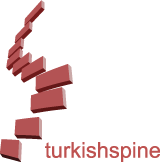ABSTRACT
Because of the differences of anatomy in vertebrae and neuro vascular structures, craniovertebral junction is divided from the other part of spinal colon with regard to surgical applications. Most of flexion-extension (35 %) and rotation (50 %) of neck are realized in this zone. Instability due to malign process,trauma,congenital anomalies, infection and connective tissue disorders in this region, fixed with posterior approach that procedure prefered by the spinal surgeons.
The first cranio-cervical stabilization was performed with thick suture application for fixing of posterior elements by Mixter and Osgood in 1910. Later, wiring and external fixation techniques were continued, then with the aid of technological developments and studies of clinical neuroradiology, the anatomy of this region is began to be understood easier. That era provides new techniques resulting biomechanically stronger internal fixation.
Nowadays, all the techniques that can be applied with neuro-navigation and imaging devices are widely used which include occipital condyle and cervical pedicle screws with benefits of high tech low profile poly axial implants. Recently, minimal invasive techniques achive more effective stabilization safely.



